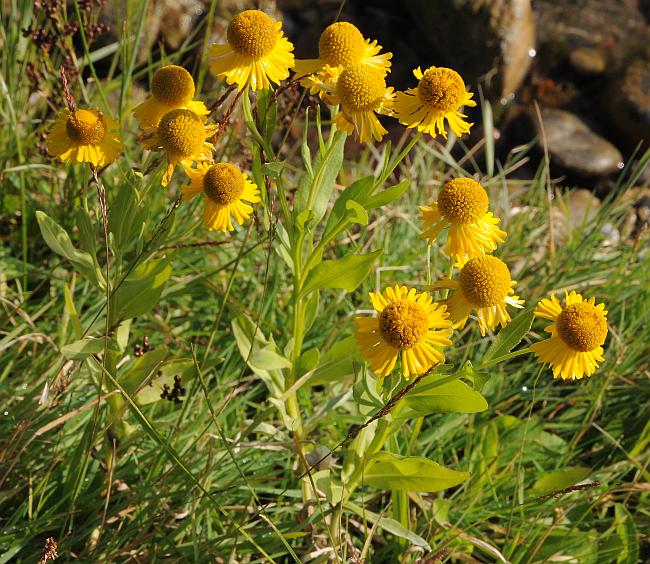Helenium autumnale L.
Common Sneezeweed

Native
CC = 5
CW = -3
MOC = 63
© SRTurner
Helenium autumnale L.Common Sneezeweed | |
 |
Native CC = 5 CW = -3 MOC = 63 |
© SRTurner |
|
Family - Asteraceae/Heliantheae Habit - Fibrous rooted perennial forb. Stem - Ascending to erect, to 1.5 m, usually branched, conspicuously winged, glabrous or sparsely to densely pubescent with short, sometimes curved or curled, more or less spreading to loosely ascending hairs, also moderately dotted with sessile to impressed, yellow glands.
Leaves - Alternate, simple, sessile, glabrous or more commonly moderately to densely pubescent with short, sometimes curved, mostly spreading hairs, also densely dotted with sessile to impressed, yellow glands. Basal and lowermost stem leaves absent or withered at flowering. Median and upper stem leaves 4-15 cm long, lanceolate to oblanceolate or obovate, unlobed, the margins entire or toothed (often only above the midpoint), tapered at the base, long-decurrent as narrow wings of green tissue along the stem, angled or tapered to a usually sharply pointed tip.
Inflorescence - Solitary heads terminal on branch tips, or appearing as loose, open clusters or open, leafy panicles, the heads appearing mostly long-stalked.
Heads - Radiate. Involucre saucer-shaped, 8-20 mm long, 8-23 mm in diameter, the outer series of involucral bracts fused at the base, the midnerve inconspicuous, not thickened, the outer surface moderately to densely pubescent with minute, curved hairs, both surfaces also moderately gland-dotted. Receptacle strongly convex, hemispherical to nearly globose, often slightly enlarging as the fruits mature, naked.
Florets - Ray florets 8-21 in usually 1 series, pistillate, the corolla 8-25 mm long, relatively broad above a slender base, yellow, the tubular portion and the undersurface of the ligule with sparse to moderate, minute, curled hairs and also with moderate to dense, sessile and spherical or somewhat impressed, yellow glands. Disc florets numerous, perfect, the corolla 2.5-3.5 mm long, yellow, glandular, the 5 sharply pointed lobes also glandular on the outer surface. Style branches with the sterile tip slightly expanded and more or less truncate. Pappus of 5-7 scales, 0.5-0.9 mm long, these papery and white or thinner and nearly transparent, lanceolate to narrowly ovate, tapered to a relatively short-awned tip, the margins usually slightly irregular.
Fruits - Achenes 1-2 mm long, narrowly wedge-shaped, with 8 often lighter-colored ribs, the surface brown, moderately to densely pubescent with white to straw-colored hairs, mostly along the ribs. Flowering - August - November. Habitat - Pond margins, streambanks, sloughs, fens, marshes, calcareous seeps, ditches, moist open disturbed areas. Origin - Native to the U.S. Lookalikes - H. flexuosum. Other info. - This attractive species is found across most of Missouri, excepting the Bootheel and a large part of the northwestern region of the state. Its continental U.S. distribution forms a patchwork across the entire country, and it also ranges into Canada. Its presence always indicates substrate which is at least seasonally wet. Photographs taken at Shaw Nature Reserve, Franklin County, MO, 9-16-2006, Weldon Spring Conservation Area, St. Charles County, MO, 10-21-2007, Tyson County Park, St. Louis County, MO, 9-1-2017, in Green River, Sweetwater County, WY, 8-22-2019, and at Indian Camp Creek Park, St. Charles County, MO, 10-7-2019 (SRTurner). |